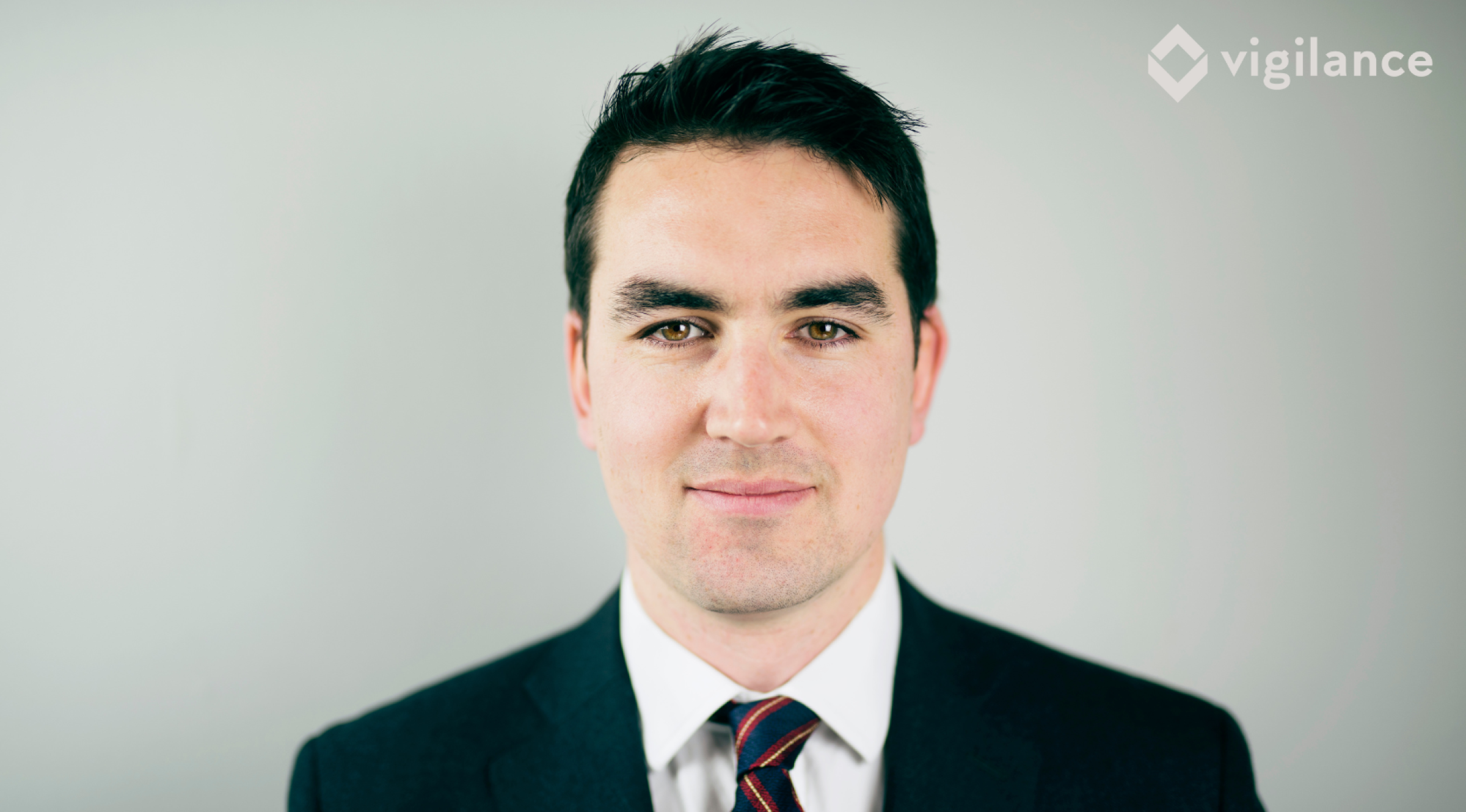Send us a message
Tel: 0203 416 5340



News 13.06.24
In the dynamic field of risk management, adaptability and innovation are paramount. Over a fifteen-year journey that began in the British Army, moved through Deloitte's Risk Advisory team, and now resides as Director of Risk at Vigilance, George Waterfield has navigated diverse risk landscapes with consistent principles.
This article shares insights from George's career at Vigilance, highlighting the groundbreaking risk analysis platform and the innovative technologies deployed to secure vacant commercial properties.
From mitigating strategic risks to leveraging AI in surveillance, readers will discover how Vigilance is at the forefront of proactive risk management.
Dive into current trends, challenges, and the future of risk management in the security sector, as seen through the eyes of an industry leader.
“Can you give us a quick overview of your timeline at Vigilance and your previous experience in risk?”
I have been involved in risk management for over fifteen years, starting as an officer in the British Army, then moving to Deloitte in their Risk Advisory team, and now leading the risk management within Vigilance. Each career stepping zone involved managing very different types of risk, but the principles of managing them are largely the same. I began my career in Vigilance within the Operations team, where I developed the company’s risk-led approach to security and introduced corporate risk management. I also designed and built our platform, which enables any manager within the business to analyse the risk profile of a potential assignment. This analysis delivers a non-prejudiced output showing the impact and likelihood of different risks for that particular assignment. This provides vital input when designing the security service plan to mitigate identified risks.
"Can you describe your role as Director of Risk at Vigilance and the core responsibilities that come with it?"
I am responsible for developing and managing the risk function within the business, ensuring strategic business risks are identified and appropriately mitigated, and ensuring departmental heads are managing the risks within their functions so that the business can continue to run effectively. I am also responsible for driving the Risk Lead Security operations on which we base the delivery of our services to customers. I lead the process that provides the tactical risk analysis and security mitigation recommendations for our assignments. I also maintain and develop the risk tools within the business to ensure we continuously improve the service we deliver to our customers.
"What does a typical day look like for you, and what are the most common challenges you face in your role?"
Much of my time is spent looking at opportunities provided by the commercial team and generating security risk reports for them, which form the basis of our proposals. When I’m not writing reports I’m developing the various risk platforms and tools we have, looking to make improvements where I can and identifying opportunities to add further value and insight for our customers.
"What are the current risk trends affecting the security of vacant commercial properties?"
Vacant commercial properties will always face certain risks due to the very fact that they are vacant; squatting is a constant risk; the laws protecting vacant commercial premises against this are weak and so if a squat is established it can be very time consuming and costly to both remove the squat and rectify any damages caused. Aggravated trespass, although usually seasonal, remains a constant threat to properties with large areas of hard standing; if an illegal encampment is established, often what follows is that the utility service cables and pipes within the buildings are cut out and removed and areas within the site are used for the illegal dumping of waste. This can lead to huge costs to rectify damages and clear away waste, all while delaying the potential lease or sale of the property.
Currently, we are observing pre-planned actions to strip copper and other valuable fixtures from within vacant commercial buildings, involving small groups of people who cut through perimeter fences before breaking into the buildings. They are using the cover of darkness, areas not covered by surveillance equipment or routes concealed by dense vegetation to approach the buildings before gaining entry. Probing will often occur before the main event to determine surveillance coverage and the speed and efficacy of the response. They will cut out the valuable materials into manageable pieces, before carrying it out of the site by the way they entered. If this is not detected, they often return to continue their operation until all the material has been removed.
"How do geopolitical or economic changes impact your risk management strategies?"
We certainly see an uptick in theft when economic times are hard. Theft of metals and other high-value materials and fly-tipping are common occurrences on vacant properties as they often need to be more adequately secured. Prominent buildings can also be a target for activism, whether that be attempts to occupy the building or cause criminal damage to gain publicity, as we have seen with groups such as JSO, etc.
"Where do you see these trends heading in the next few years?"
Sadly, I don’t see these risks diminishing any time soon. Risks associated with activism, which results in direct action by groups within the UK will remain, particularly as we see instability increasing across the globe. These risks will sit mainly with the prominent buildings within major city centres as this is where you can best achieve publicity. Risks such as theft and aggravated trespass will most likely continue to rise, but those risks will mainly affect premises in business and industrial parks rather than in city centres.
"What are some of the emerging technology solutions that Vigilance is currently exploring or implementing?"
Technology is advancing rapidly in our sector, and there are some good systems on the market. While the range of systems may look a little different from one another, their overarching objective is to identify when something or someone is somewhere they shouldn’t be and then trigger a process to get a security response, whether that be a licensed security officer or the police. A key feature to look for when choosing a particular system is reliability. We have designed and currently use a very reliable, robust, and flexible camera system to achieve this effect, which is enhanced with AI to better identify issues within the images it takes; it is solar-powered and works on the mobile data network, so it can be placed almost anywhere to overwatch any vulnerable area. Its versatility allows it to be targeted at specific vulnerabilities, rather than being used to scan a wide area. These images are monitored 24/7 from our control centre, so an escalation process can be triggered within seconds of the camera detecting an issue.
"Can you share a recent innovation that has significantly improved your operations?"
As part of Risk Lead Security, I have always tried to use available relevant data to drive the security risk analysis of assignments so that the services we recommend are appropriate and effective. Recently, I have led the development of the Vigilance Alerts platform; a specific tool that uses different risk-relevant data sets, which are then treated and layered on a map of the UK. Each layer interacts to give a risk score for specific areas and individual assignments; this helps inform the security mitigations we recommend. The level of detail we can go into is amazing, from looking at the local crime statistics, prosecution rates, deprivation, fly-tipping levels, and even the up-to-date flood risk. All these aspects are put into the reports generated for the assignments and show that we don’t just put our finger in the air or give a shopping list of services when making recommendations.
"How do you evaluate which new technologies could be beneficial for your risk management protocols?"
The most important aspect of any technology we use is whether or not it provides value, i.e., does it deliver an effect that contributes to improving the security of the assignment? Many of the assignments we protect that have technology are blended with other services, such as physical obstacles and licensed officers; these sites are varied in terms of type, status, and location. Because of this, we look for technology that can consistently and reliably identify issues, overwatching any vulnerability in any part of the country. It's all very well having a system that can identify a problem, but if you don’t follow up with an action, the technology is of no use.
"What are some of the key achievements in your career at Vigilance that you are particularly proud of?"
I think my main achievement is developing the company security risk analysis, which forms the backbone of how we deliver our services. I’ve made some tweaks over the years, but the principles behind it have remained the same, and it enables us to give our customers an honest assessment of what they need to protect their properties. That or running the Brighton Marathon for the GWT...
"Looking back, what lessons have you learned about managing risks in the security sector?"
You always have to keep moving forward and improving your systems. We are against very determined people who want to break onto our sites and cause mischief. Whenever we implement a solution to mitigate a particular risk it is only a matter of time before they find a workaround. No solution is perfect, and if something is working today there are no guarantees that it will work tomorrow; you have to continually adapt and improve to stay ahead of the game!
"What advice would you give to other risk management professionals in the security industry?"
Almost everything in the security industry boils down to risk. Our industry is there to treat the risks to our customers’ assets. The most important step is identifying the risk; you will struggle to mitigate a risk you haven’t identified.
“Any final thoughts, future visions for the company, or upcoming projects?”
The project I am working on should take us to a level beyond Risk Lead Security. The development will be a serious disruptor within our industry and will be of huge value to our customers and key stakeholders. All I can say about it is watch this space...

© Vigilance Properties Limited 2025. Registered in England & Wales under company registration number 06682999. Vat No. 939424007